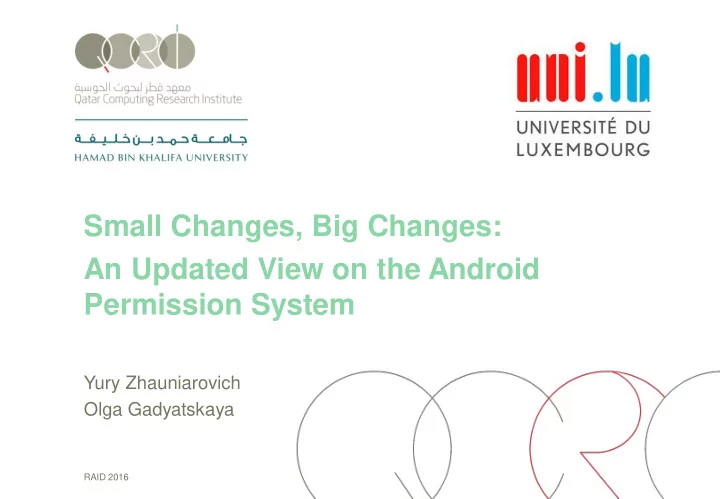

Small Changes, Big Changes: An Updated View on the Android Permission System Yury Zhauniarovich Olga Gadyatskaya RAID 2016
Sensitive Resource Protection in Android • Android is the most popular mobile OS: - ~ 2 billion of third-party apps only on Google Play - many more markets exist - a lot of malware/adware/greyware/ … • The end users can control access of third-party apps to their sensitive data via permissions • Permissions is a general way how access to sensitive resources is controlled on Android 2
Android Permission System • Android Permission is a security label assigned to a sensitive resource that protects the access to this component. Once an app is granted with the permission it receives access to the corresponding resource • Permissions may belong to a permission group , a category of permissions protecting similar functionality • Permissions are declared in AndroidManifest.xml files • Permissions: - Platform – defined within the sources of Android protecting the components of the operating system - Custom – declared by third-party developers protecting the resources of the application 3
Established View on the Permission System • All permissions are granted at the installation time or the application is not installed • Granted permissions cannot be revoked • There are 4 protection levels: - normal (granted automatically) - dangerous (granted after user ’ s approval) - signature (granted only if the packages declaring and requesting permissions are signed with the same certificate) - signature|system (similar to signature, but also granted if the application is installed on the system image) • Only dangerous permissions are approved by the user 4
Updated View on the Permission System (23+) • Permissions: - Installation time (normal, signature, signature|system) - Runtime (dangerous) • Installation time permissions are granted at install and cannot be revoked • Runtime permissions are disabled by default, granted when required (according to an app developer) and can be revoked 5
Motivation • Permission system is a central component for the Android security • Permissions are used in many research articles exploring the Android security • The detailed exploration of the Android permission system for the scientific community has been done in 2009 ( “ Understanding Android Security ” by W. Enck et al.) • In Android 6.0 (Marshmallow), the permission model has been considerably changed 6
Our Approach • We analyzed 16 versions of Android resulted in API change (from 1.6 [Donut] up to 6.0 [Marshmallow]) • We developed scripts: - to extract declared permissions and their properties from the manifest files - to compare the extracted data for different versions of Android • We applied our software to the considered versions and performed quantitative and qualitative analysis of the changes • In this work we concentrated on the platform permissions • We divide platform permissions into: core, package, sample, test BONUS: • For this presentation, we also included the analysis of Android 7.0 [Nougat] released on August 22, 2016 7
Permission Declaration 8
Permission Declaration 9
Permission Declaration 10
Permission Declaration 11
Permission Declaration 12
Implementation Details PermissionInfo.flags parsed from android:permissionFlags PermissionInfo.protectionLevel parsed from android:protectionLevel 13
Quantitative Analysis 14
Permission Amount of Different Manifest Types • Number of core permissions is considerably higher than others • Permission number grows: - New platforms (TV, Auto) - New packages (Launcher3, etc) - Old packages are not removed (e.g., Launcher2) 15
Permission Amount of Different Manifest Types • Number of core permissions is considerably higher than others • Permission number grows: - New platforms (TV, Auto) - New packages (Launcher3, etc) - Old packages are not removed (e.g., Launcher2) 16
Permission Number of Different Protection Levels Core Package 17
Analysis of Permission Number Changes • Android 6.0 (API 23) – signature|system is deprecated 18
Amout of Permission Groups • Android 6.0 (API 23) – permissions are granted on per group basis 19
Qualitative Analysis 20
Important Changes • Runtime permissions - User can revoke runtime permissions - Granted per permission group • Not uniform behavior of apps: - Backward compatibility of old apps with the new platform o Old style installation process (all permissions are granted) o Permissions are granted and revoked through AppOps system o Only core permissions are “ truly ” runtime - Forward compatibility of new apps with older platforms o Developers must add additional checks for some permissions (e.g., WRITE_CALL_LOG, READ_CALL_LOG, READ_EXTERNAL_STORAGE) 21
Important Changes • UID sharing: - Changes of runtime permission in one application influence on the permission state in other application • Signature permissions can be requested by third-party apps: - Appop permissions can be granted by the user (PACKAGE_USAGE_STATS, SYSTEM_ALERT_WINDOW, WRITE_SETTINGS) - Development permissions can be granted to third-party applications through “ pm grant ” command - Permissions with FLAG_PRE23 set are granted automatically to apps with the target SDK level below 23 • Some dangerous permissions are now normal: - Some highly sensitive dangerous permissions are now normal (e.g., INTERNET, NFC, BLUETOOTH, etc.) 22
Summary • Permission system is far from being stable • Amount of permissions grows with every new release • Considerable changes in Android Marshmallow • Permission changes protection level often => security researchers must acknowledge this in their tools 23
Thank you!
Recommend
More recommend